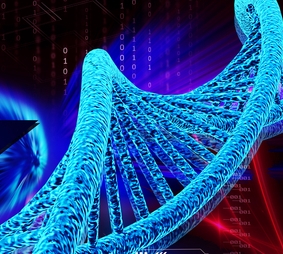From RealClearScience
Unknown Selective Force Shapes Bacterial Evolution

« How to Examine Rocks 163 Million Miles Away | Newton Blog Home Page | Science Wants to Control Your Mind! »
Most organisms' characteristics are shaped by the process of natural selection. For instance, slow bunny rabbits get eaten by wolves, so nature has selected for the survival of fast bunny rabbits. But, not all traits are under such intense selective pressure. Indeed, some aren't under any selective pressure at all. Therefore, these traits may be random, and over time, differences between species can develop purely by chance.
In bacteria, one example of such a characteristic is called the "G+C content." Recall that DNA is made up of nucleotides: A, T, G and C. The A and T pair together (A+T) in the DNA double helix, as do the G and C (G+C). After a bacteria's genome is sequenced, the G+C content is calculated simply by adding up all the G's and C's and dividing that number by the total number of nucleotides. The percentage, which can range from 13% to 75%, tends to be characteristic of the bacterial species. Why one species is, say, 47% and another is 58% is thought to be due solely to chance. Luck of the draw.
Or, at least that's what scientists thought until a few years ago when evidence emerged that random mutations were biased: they were more likely to generate A's and T's. But, now, a new paper in PNAS shows that an unknown selective force appears to nudge bacteria in the other direction. Bizarrely, simply possessing genes with a higher G+C content makes the bacteria grow faster.
To determine this, researchers from Yale University used many different versions of a gene called GFP which were identical in amino acid sequence, but differed in DNA sequence. (Because the genetic code is degenerate, different DNA sequences can yield identical proteins.) They found that bacteria given GFP genes with a higher G+C content grew faster -- even though the protein they produced was identical to the proteins the other bacteria produced.
It gets weirder. The GFP gene itself is completely useless to bacteria. GFP stands for "green fluorescent protein" and it was isolated from a jellyfish. It is irrelevant to the health and welfare of bacteria.
What exactly is going on is rather a mystery. If all other things are equal (e.g., if a phenomenon known as codon bias has been accounted for), then it really shouldn't matter what the exact DNA coding sequence is for any given protein -- particularly if the protein sequence isn't altered (and especially if it's useless!).
But, what is perhaps clearer is that what was once thought to be randomly generated DNA sequences, in actuality, was the subtle craftsmanship of the ever-present force of natural selection. [My emphasis - D.G.]
Source: Rahul Raghavan, Yogeshwar D. Kelkar, and Howard Ochman. A selective force favoring increased G+C content in bacterial genes. Published online before print August 20, 2012, doi: 10.1073/pnas.1205683109 PNAS August 20, 2012.
(Image: DNA via Shutterstock)
In bacteria, one example of such a characteristic is called the "G+C content." Recall that DNA is made up of nucleotides: A, T, G and C. The A and T pair together (A+T) in the DNA double helix, as do the G and C (G+C). After a bacteria's genome is sequenced, the G+C content is calculated simply by adding up all the G's and C's and dividing that number by the total number of nucleotides. The percentage, which can range from 13% to 75%, tends to be characteristic of the bacterial species. Why one species is, say, 47% and another is 58% is thought to be due solely to chance. Luck of the draw.

Or, at least that's what scientists thought until a few years ago when evidence emerged that random mutations were biased: they were more likely to generate A's and T's. But, now, a new paper in PNAS shows that an unknown selective force appears to nudge bacteria in the other direction. Bizarrely, simply possessing genes with a higher G+C content makes the bacteria grow faster.
To determine this, researchers from Yale University used many different versions of a gene called GFP which were identical in amino acid sequence, but differed in DNA sequence. (Because the genetic code is degenerate, different DNA sequences can yield identical proteins.) They found that bacteria given GFP genes with a higher G+C content grew faster -- even though the protein they produced was identical to the proteins the other bacteria produced.
It gets weirder. The GFP gene itself is completely useless to bacteria. GFP stands for "green fluorescent protein" and it was isolated from a jellyfish. It is irrelevant to the health and welfare of bacteria.
What exactly is going on is rather a mystery. If all other things are equal (e.g., if a phenomenon known as codon bias has been accounted for), then it really shouldn't matter what the exact DNA coding sequence is for any given protein -- particularly if the protein sequence isn't altered (and especially if it's useless!).
But, what is perhaps clearer is that what was once thought to be randomly generated DNA sequences, in actuality, was the subtle craftsmanship of the ever-present force of natural selection. [My emphasis - D.G.]
Source: Rahul Raghavan, Yogeshwar D. Kelkar, and Howard Ochman. A selective force favoring increased G+C content in bacterial genes. Published online before print August 20, 2012, doi: 10.1073/pnas.1205683109 PNAS August 20, 2012.
(Image: DNA via Shutterstock)




